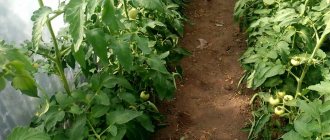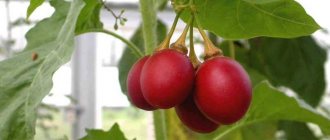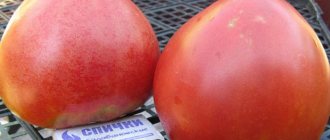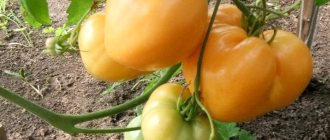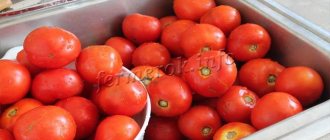» Vegetable growing » Tomatoes » Tomato variety Pinocchio
0
1626
Article rating
The result of domestic selection, the Pinocchio tomato, is popular not only on farms, but also on amateur plots. It was released in 1970 and literally went through all the research in just a few years. In 1973 it was included in the State Register. The variety is unique in that it can be grown even at home, in pots.
- Advantages and disadvantages
- Growing in open ground
- Landing
- Care
- Growing on the balcony
- Landing
- Care
- Growing on a windowsill
- Landing
- Care
- Disease and pest control
- Gardeners' opinion
Tomato variety Pinocchio
Description of the variety
The Pinocchio tomato is a dwarf tomato variety. Its small growth allows it to be grown not only in the country, but also on the windowsill and balcony. At the same time, it is possible to obtain a large harvest of cherry tomatoes.
Features of Pinocchio
The main feature of the Pinocchio variety is its dwarfism. Thanks to this, the tomato has a decorative appearance. Make sure of this by looking at the photo.
This is interesting! The Pinocchio tomato is often grown in flower beds. At the moment of fruit formation, the bushes look very decorative. Their greenery is almost invisible under a large number of beaded fruits.
The fruits are juicy, but not watery. They contain an increased concentration of nutrients. 100 g of Pinocchio tomatoes contain the daily dose of iron, potassium, vitamins B, C and A necessary for a person.
Characteristics of a dwarf tomato
Growing a tomato is not difficult. It is easy to care for.
Description and characteristics of the Pinocchio variety:
| Parameter | Indicators |
| Bush type | determinant. Growth stops as soon as the superior ovary is formed. The maximum height of the plant is 40 cm. The bushes are strong, well-leafed, and shaped like a ball. The leaves are dark green, tomato-potato in shape. The root system is weak |
| Growing method | Suitable for growing in greenhouses and unprotected soil. Can be planted in boxes and flowerpots |
| Productivity | high - 1-1.5 kg of crop is harvested from one bush. Indicators decrease when growing tomatoes in pots. Up to 10 bushes are planted per square meter, so from 1 sq. m get up to 12 kg of fruit |
| Fruit | Pinocchio tomatoes are miniature in size. The maximum weight of one fruit of regular round shape is 40 g. There is no ribbing at the base. The taste of the fruit is pronounced sweet, with a slight sourness and a fruity aftertaste. Inside there are 2-3 chambers with small seeds. Fruits are formed in clusters, 10 pieces on each |
| Transportability | high - the skin of tomatoes is very strong, glossy and thin. Can be stored for up to a month |
| Ripening time | mid-ripening variety - the fruits ripen 90 days after seed germination. All Pinocchio tomato berries ripen almost simultaneously. After all the tomatoes are ripe, the bush dies |
| Disease resistance | has high immunity to all tomato diseases. Thanks to its early ripening, it is not even affected by late blight. |
Note! In the Russian register, Pinocchio is recorded as a mid-season variety. But many manufacturing companies position it as an early ripening crop. The fruits ripen within 90 days after emergence.
Agricultural technology for growing Pinocchio tomatoes
Tomatoes of this variety are quite unpretentious, however, like any other plant, they need appropriate care. Initially, you need to decide on the timing of planting the seeds. They depend on the harvest date the gardener needs.
Tomatoes are required by the end of December, sowing should be done no later than October. If planted in early January, the fruits will ripen by March. The lack of light, which manifests itself in the autumn-winter period, negatively affects the condition of the bush. To prevent this, you need to use additional luminescence; phytolamps are best suited.
In the summer, it is best to take tomatoes out into the fresh air in spacious containers about 10-15 cm high. If unexpected frosts or prolonged downpours occur, the tomatoes will simply need to be brought indoors, closer to the light (on the windowsill).
You can use a universal soil mixture for tomatoes; it is easy to make yourself. To do this, you need to mix humus, peat, sand, wood ash or shavings, coal chips and regular garden soil.
Among mineral fertilizers, the Pinocchio variety, like all tomatoes, prefers potassium and nitrogen fertilizers. It is not recommended to abuse organic matter; urea and humus can be used in limited doses.
Watering should be done regularly, but not frequently. It is enough that the soil does not dry out and the water does not stagnate.
The tomato does not tolerate low temperatures, dry air and exposure to direct rays, so in summer, in especially sunny weather, the bush must be shaded.
Rules for growing seedlings
Like other tomatoes, Pinocchio is grown in seedlings. Even when cultivating tomatoes on a windowsill, you cannot sow the seeds immediately into a large container. This will negatively affect their productivity.
Seeds are sown 60 days before the intended planting of seedlings in the ground. Therefore, preparatory work begins in the first half of May.
When growing tomatoes on a windowsill, the seeds are planted at any time of the year. At home, the plant is grown even in winter.
Preparation of planting material
According to gardeners, Pinocchio seeds have almost one hundred percent germination rate. Despite this, a number of preparatory work is carried out before sowing.
To test the seeds for germination, they are soaked in saline solution for half an hour. The floating planting material is removed, and the material that has sunk to the bottom is washed and used for planting.
Some manufacturers treat planting material with a disinfectant. These seeds are colored green or orange. If the seeds have not undergone this treatment, they are soaked for half an hour in a light pink solution of potassium permanganate.
Before planting, planting material is treated with a growth stimulator. Pieces of gauze are soaked in the solution, after which the seeds are wrapped in them. The time for seed treatment depends on the instructions for use of the product.
The most popular growth stimulants:
- "Epin";
- "KKM-1";
- "Zircon".
Choosing a container and soil for growing Pinocchio
For sowing, use large plastic trays, wooden boxes or homemade containers. If you plan to grow several plants at home, it is more convenient to use peat tablets.
To plant seedlings into individual containers, small containers are used. For example, peat or plastic pots, disposable cups or cut-off bottles.
To grow adult bushes on the windowsill and balcony, use pots or flowerpots. Their volume must be at least 2 liters. It is possible to plant adult plants in wooden boxes - no more than 10 tomatoes per 1 square meter. m.
There are many options for preparing soil for growing tomato seedlings. The best of them is considered to be a mixture of turf, peat and humus taken in equal parts. For each box of earth, add a glass of ash.
The soil mixture and containers for tomatoes are disinfected - calcined in the oven or poured with boiling water.
Sowing seeds
In the prepared soil, grooves are made 1 cm deep. The distance between them should be at least 3 cm.
Seeds are placed in the grooves at a distance of 2 cm from each other, covered with earth on top. The soil cannot be compacted.
The earth is moistened with a spray bottle. Cover the container with film and place in a warm place. Watering is not necessary until the planting material germinates.
Seedling care
Caring for Pinokkio seedlings must comply with all basic rules. There are not many of them, but they are very important:
- After germination, the seeds are moved to a well-lit place. If there is not enough light, then fluorescent lamps are used.
- The film is removed a week after the seeds have grown. Plants do well at room temperature.
- Before picking, water the plants using a pipette or syringe. When the tomatoes are transplanted into separate pots, use a watering can. The water should be warm and settled.
- When picking tomatoes, it is important not to damage the roots. The root system of Pinocchio tomatoes is weak, so it is impossible to break off a third of their central root.
- The seedlings are fed with complex fertilizers containing phosphorus. The first time fertilizer is applied 14 days after picking the plants, the next time after another 2 weeks, and the last time 3 days before transplanting the tomatoes to a permanent place.
- Tomatoes are hardened two weeks before transplanting into open ground. To do this, they are taken out into the fresh air, gradually increasing the time spent outside.
Features of planting and growing
Tomato Pinocchio can be sown immediately in a permanent place. When grown in open ground, it can be planted both in beds and flower beds, with a planting density of 7–8 bushes per square meter.
If tomatoes are grown in seedlings, the seeds can be sown in cut plastic bottles filled with fertile purchased soil (sowing is done in March):
- The seeds are buried 1.5–2 cm and sprinkled with peat.
- Plantings need to be covered with film to create a greenhouse effect.
- After 5–6 days, germination will begin.
Seedlings feel best at temperatures of 18–19 ºС at night and 24–26 ºС during the day.
Like other varieties of tomatoes, Pinocchio must be watered when the top layer of soil dries out. With the appearance of 2–3 true leaves, the plants are planted, and at the age of 45–50 days they are transplanted to a permanent place.
Video: growing Pinocchio tomato on a windowsill
Caring for Pinocchio is not difficult - you just need to water and feed it on time:
Recent Entries
5 working ways to use tar in the garden 7 indoor plants that help you get married even in adulthood Indoor plants that can bloom in trouble
- during the period of active growth, nitrogen fertilizers are required;
- When setting and ripening tomatoes, it is better to use potassium fertilizer.
In any case, feeding should not be too frequent - approximately once every 12–14 days. It is very useful to use mullein (diluted with water 1:5, the norm is 1 liter per bush), as well as ready-made complex fertilizers: Kemira, Kristalon, Master, Mortar. These preparations can be used for both root and foliar feeding (stimulate the development and growth of plants and prevent flower falling).
Complex fertilizers for tomatoes in the photo
Kemira presents a whole line of fertilizers with different compositions
Master differs from other fertilizers in the same proportions of nitrogen, potassium and phosphorus
Crystalon is intended for application to the soil in dry form.
Rasvorin is an easily soluble fertilizer suitable for almost any vegetables.
When grown indoors, Pinocchio may suffer from insufficient lighting. When sowing in winter and early spring, seedlings must be illuminated using special phytolamps placed at a height of 25–30 cm above the plants.
Phytolamps provide the light spectrum plants need
Pinocchio does not need pinching or support, although during active fruiting it is better to tie up the bush. The fact is that the variety has a high yield and a very shallow root system, which can turn out of the ground under the weight of the fruit.
The peculiarity of this mini-tomato is that after the formation of fruit clusters, the plant begins to quickly turn yellow and does not form new flowers or ovaries. This is not a sign of disease, but a normal physiological process, so after harvesting the fruits, the bush simply needs to be eliminated and replaced with another. Therefore, if you want to admire the elegant tomato bushes for a long time, you need to sow the seeds in batches at intervals of several days. This approach will allow you to use the decorative properties of Pinocchio for a long time.
Pests and diseases
Pinocchio is highly resistant to pests and diseases. Even with high humidity in home growing conditions, it is usually not affected by rot or other fungal diseases.
With excessive watering and insufficient lighting, a “black leg” may develop on a tomato. In the fight against the “black leg”, the best way to help is to wash the soil before planting with potassium permanganate dissolved in boiling water (dark pink solution). Diseased tomatoes should be removed immediately, and the soil around them should be treated with Bordeaux mixture (1%).
With blackleg disease, the roots darken and rot.
Pests should only be feared when cultivating Pinocchio in open ground: the plantings can be attacked by slugs (spraying the soil with metaldehyde or ammonia solution will help) and cabbage grass (insecticides such as Confidor will scare it off).
From my own experience of growing tomatoes, I realized that the most important thing is timely feeding. For the first time I feed (lightly water) the germinating seedlings with potassium permanganate (pink solution). I carry out the second feeding after 1–1.5 weeks. Tea infusion works very well (1 cup of used tea leaves is poured into 3 liters of boiling water and infused for 7–8 days). This feeding is good for any other plants. To prevent midges from infesting, I stick matches head down into the soil next to the seedlings. I carry out the third feeding (again with tea) 2-3 days before picking. After transplanting to a permanent place, I do not water it for the first 9–10 days. In summer, watering should be weekly, and should be stopped at the beginning of active fruit ripening. I prefer to treat even disease-resistant tomatoes against late blight with copper-containing fungicides (twice during the growing season with an interval of 2 weeks). As a rule, no further effort is required to grow tomatoes.
How to grow tomatoes
Pinocchio tomatoes are planted in a permanent place in the second half of May. They are grown both in open and closed ground.
Some gardeners do not plant dwarf bushes in separate beds, but rather frame areas with other varieties of tomatoes or flower beds. Due to their low growth, they do not interfere with the growth of other crops. This variety is also grown in flowerpots in front of the house.
Planting seedlings in the ground
The land for growing tomatoes has been prepared since autumn. It is dug up and enriched with ash and humus. All remains of weeds and cultivated plants are removed.
In spring, the soil is dug up again and disinfected. To do this, water the soil with a weak solution of potassium permanganate.
Before planting in a permanent place, the seedlings are watered and fed. This is done 2-3 days before plant transplantation.
On the day of planting, holes are dug into the ground. It is recommended to place 7-8 holes on one square meter. Some gardeners practice more dense planting, placing 1 sq. m. up to 10 plants.
A tablespoon of ash is poured into the bottom of each hole. Plants are placed there. There is no need to deepen the bushes.
Warm water is poured into each well. The depressions are filled with soil.
Plant care
To get a rich harvest, it is important to follow all the rules for caring for tomatoes. The most important of them:
- Plants do not need to be pinched or shaped. A bountiful harvest is obtained precisely due to the large number of ovaries. Once a week, remove yellowed leaves from the bush.
- Water the tomatoes as the soil dries out. Usually do 2-3 waterings per week. Moisten the soil in the afternoon.
- Tomatoes need to be fed regularly. The first time fertilizing is applied 3 weeks after planting the plants in the ground. Then the tomatoes are fertilized every two weeks until the first inflorescences form. Experienced gardeners advise alternating mineral compositions and mullein solution. It is also useful to use foliar feeding when the first ovaries appear.
Nuances of caring for tomatoes
When growing dwarf tomatoes, consider a number of features. The tips presented in the list will help you avoid some mistakes and grow healthy plants:
- Tomatoes are susceptible to loosening the soil. This procedure improves root air exchange. Do this after each watering. During the loosening process, it is important not to damage the roots.
- Tap or well water is not suitable for watering tomatoes. Before using the water, it should sit for at least a day.
- The Pinocchio tomato does not tolerate moisture on its greens. Therefore, the bushes are watered from a watering can directly under the root.
- Pinocchio's root system is weak, so weeds easily damage it. To prevent this from happening, weeding is done at least once a week.
Diseases and pests
Pinocchio is a variety that is resistant to all tomato diseases. Thanks to the short growing season and early ripeness, it does not even suffer from late blight. Therefore, the only preventive measure it needs is to treat the seeds and soil with a disinfectant solution.
Tomatoes can be attacked by pests. Aphids, slugs, and the Colorado potato beetle appear on the bushes. The roots are damaged by the mole cricket and the larvae of the cockchafer.
All harmful insects are removed manually. To prevent their appearance on the bushes, tomatoes are treated with a soap solution or a decoction of chamomile and celandine. It is important that such products fall on the greenery and not on the soil.
To prepare a soap solution for spraying tomatoes, rub a piece of laundry soap into a bucket of water. When the soap crumbs dissolve, the product can be used.
Outdoor care
Being in open soil, the plant requires less attention and care than at the seedling stage. Watering is carried out when the soil at the base of the plants dries out - approximately once a week. The water temperature for irrigation is at least 22°C.
When a crust forms when the soil dries, it is necessary to loosen the soil. This process allows you to increase the access of oxygen to the root system, due to which it grows more actively. Loosening depth is up to three centimeters. This must be done with care so as not to damage the roots of the tomato. Loosening is carried out at least once a week. It is necessary to weed the soil as weeds appear.
The daylight hours for seedlings in open ground should be at least 12 hours, otherwise the plant will begin to wither. Fertilizers for Pinocchio tomatoes are combined. Feeding is carried out once every 10–15 days, depending on whether the tomato is growing or bearing fruit. If the plant has fruits, it is necessary to add potassium fertilizers. Before this, the soil needs nitrogen enrichment.
It must be remembered that after fruiting the tomato will begin to turn yellow and wither. This is a normal process, since the Pinocchio variety does not produce a second ovary. When you start to notice an abundance of wilted leaves, you will need to replace the bush with a new one.
Features of growing tomatoes in a greenhouse and open ground
When growing Pinocchio in a greenhouse, there are usually no difficulties with care. The only advice regarding this method of planting is that greenhouses need to be ventilated daily.
There are more difficulties in open ground. In the first week after transplanting into the soil, the seedlings are covered with film at night. In such conditions, it is necessary to mulch the beds, which will protect the bushes from pests and freezing.
When planting tomatoes on a balcony or windowsill, you need to use pots of at least 2 liters. The bushes are watered daily with a small amount of liquid. You will also have to loosen the soil every day.
In winter, tomatoes lack sunlight. Therefore, you need to use fluorescent lamps.
It is important! Pinocchio tomatoes have a short growing season. They begin to wither as soon as all the fruits ripen. After harvesting, old plants are replaced with new ones.
Growing on a windowsill
Slightly different from that on the balcony. For homemade tomatoes, it is important to maintain the correct temperature within 23 degrees during the day and 18 at night. Lighting for these plants is required. For full development, they need at least 12 hours of daylight. Water homemade tomatoes so that the entire earthen ball is completely wet. When feeding, complete fertilizers are first given, and with the beginning of flowering and fruiting, potassium salt is additionally added to the fertilizer mixture.
The Pinocchio tomato will not produce a huge harvest, but small ornamental bushes will not only delight the eye with their appearance, but will also provide delicious tiny fruits.
Harvesting and application
Pinocchio tomatoes ripen in early July. All the fruits on the bushes will ripen almost simultaneously.
The fruits are arranged on clusters of 8-10 pieces. You need to pick off the whole brush at once.
Tomatoes are best stored on the trusses. They are placed in the refrigerator in individual plastic containers.
Pinocchio tomatoes are suitable for fresh consumption and canning. Due to their concentrated flavor, they are often used for drying. Therefore, from a gastronomic point of view, the variety is considered universal.
Tomato Pinocchio: reviews from gardeners about the variety
Tomato Pinocchio: photo of variety
Alexey Petrovich, Tyumen region: “I’ve been growing the Pinocchio tomato variety for the first year, and I’m pleased with it. With the right care measures, Pinocchio tomatoes turn out to be really tasty. Even if the yield of the Pinocchio tomato is not as high as we would like, the taste makes up for everything"
Tatyana Alekseevna, Sverdlovsk region: “My sister advised me to buy Pinocchio tomatoes. The fruits can be used to make salads, pastas, or simply eaten fresh. My children really liked the little Pinocchio tomatoes, as they are very sweet and tasty, they can be eaten straight from the garden.”
Gardeners speak positively about Pinocchio tomatoes, emphasizing that they store well.
They can withstand transportation over long distances, without losing their external qualities and taste characteristics, while remaining very healthy tomatoes. Tomato Pinocchio: video about the variety
Advantages and disadvantages of the variety
Pros of the Pinocchio variety:
- precocity;
- high productivity;
- ease of care;
- the possibility of growing in open and protected ground, as well as on the balcony and windowsill;
- great taste;
- rich composition;
- versatility of crop application;
- uniform fruit ripening;
- resistance to diseases.
Disadvantages include a short growing season and a weak root system. No other disadvantages were identified in the variety.
Planting seeds
In order to successfully plant the material without reducing germination rates or harming the plant, you should follow a certain order of work:
- You need to prepare a soil mixture containing peat and a pot for growing tomatoes, providing it with special holes for drainage, lining the bottom with expanded clay, nut or onion peels.
- It is recommended to use plastic or peat cassettes as containers; disposable dishes are suitable. It must be thoroughly disinfected with a fungicide solution.
- Then you need to completely disinfect the soil by calcining it in the oven and treating it with a solution of potassium permanganate. After the procedures, the substrate must sit for at least 3 weeks so that the infusion has time to take effect and dry completely.
- Place the seeds in the soil no more than 1 cm deep and water carefully. You can sprinkle a small layer of sand on top.
- Tomatoes should be provided with greenhouse conditions: cover with cellophane film, place in a well-lit, warm place, ventilate and moisten the soil from time to time.
- When several shoots appear, the shelter can be removed. And after the formation of 2-4 healthy leaves, it is necessary to start picking and fertilizing.
Farmer reviews
Tomato Pinocchio has only good reviews. This variety surprises with its rich harvest and ease of care.
Alexandra Ivneva, Sochi: “I grow Pinocchio tomatoes in open ground. I plant them near beds of other varieties. They produce their harvest first and do not interfere with other plants. The fruits taste great and look great in salads.”
Ivan Karpov, Moscow: “I’ve always wanted to garden, but I don’t have my own summer cottage. Based on recommendations from friends, I tried to grow Pinocchio tomatoes right on the windowsill. Now they harvest about a kilogram of delicious tomatoes from each bush all year round.”
Diseases and pests
Pinocchio tomatoes have excellent immunity. Tomatoes grown in open ground sometimes suffer from late blight. For preventive purposes, the beds are kept clean, the plantings are not allowed to become thickened, and watering is carried out only at the roots. In case of disease, plants are treated with phytosporin.
At home, tomato bushes can be attacked by midges living on flower crops, thrips or aphids. Spraying with a soap solution, infusion of onion peels or garlic feathers helps.
You can learn more about Pinocchio tomatoes by watching the prepared video
Pinocchio tomatoes growing at home
growing at home
If we sow tomatoes in January, then in May we can already taste the harvest!
Seed preparation
To know for sure that the seeds will sprout, you can germinate them. There are interesting ways in the article “How to speed up seed germination.”
Or just put them in a damp cloth in a warm place for a couple of days. Alla Shirokova gives wonderful advice in the comments to the article “How to sow seeds with all your heart”: “In Vladimir Megre’s book “Anastasia” in the chapter “The Seed-Doctor” there is very good advice: before planting, take one or more small seeds into your mouth and keep it in your mouth, under your tongue, for at least nine minutes. Then put it between the two palms of your hands, hold them like that for about thirty seconds……… Open your palms, and carefully bring the seed that is in your hand to your mouth.
And exhale the air from your lungs onto the seed. You warm it with your breath, and the tiny seed will know what is in you... And the seed will determine the moment of its sunrise. The planets will all help him with that!..
AND NO PRE-TREATMENT OF SEEDS!!!! But, if you think that seeds should undergo traditional processing before sowing, then take a look at the article “Treatment of seeds before sowing”.
Soil preparation
Tomatoes love fertile soil with the addition of humus. Loose, permeable, moist. Homemade tomatoes need a lot of moisture, and the roots do not like stagnant water and dampness. It is necessary to provide good drainage in the pots. Choose a suitable pot size so that the tomatoes have enough space and nutrition.
For short varieties (up to 50 cm), a 5-7 liter pot will be enough. Let everyone grow such a tomato on their windowsill!
Sowing tomatoes
You can sow one seed at a time into a large pot (choose the largest). But it’s better to sow a few seeds in a small container. Pour warm water and cover with film until germination.
Then we remove the film and place it on a window sill that is cool to 18°C so that it does not stretch out. We wait for the tomatoes to have two or three true leaves. We select the strongest from the seedlings and plant them.
When replanting, we deepen the plants to the very cotyledon leaves, so that more roots can form. The plant will be more powerful.
Features of caring for a “homemade” tomato
- Watering . There is no need to water tomatoes often. But make sure that the soil in the pot does not dry out. It is better to water twice a week properly, completely moistening the entire earthen ball, than to water a little every day - the soil inside may remain dry. If the air at home is very dry, spraying will help. Spraying . Tomatoes do not really like water on their leaves in cold weather, but in an apartment in dry air you can spray them with water. Just don’t do this during the flowering period. Additional lighting. When planting this early, the plants need additional lighting. The days are still short, there is little light. Feeding. While plants are growing and gaining strength, they need nitrogen fertilizers. And during the period of formation and ripeness of fruits - potassium.
If you still have any questions about growing tomatoes at home, I suggest watching the video. Growing tomatoes on a windowsill in winter is no longer a secret for you. You can read other interesting articles:
Pinocchio - tomatoes from the window
Hello, dear readers! I have already told you about the different varieties of tomatoes that I had to grow on the site, both in a greenhouse and in open ground. You can read about this here and here.
But these were all ordinary garden tomatoes, and today we will talk about indoor Pinocchio tomatoes , which I planted for the first time in the summer of 2014, and have already waited for the harvest. Potted tomatoes are interesting!
Why did I need indoor tomatoes? I wanted the tomato bush to be compact enough to grow successfully in a flower pot, and there would be small ripe tomatoes in the window. To my delight, to people’s surprise!
For this reason, I purchased Pinocchio seeds. Judging by the description on the bag, the variety fit the mini-tomato category. Tomato Pinocchio: cultivation The seeds were sown in June.
The seedlings sprouted together, and since it was summer outside, I took the box of tomatoes outside. The plants did not stretch, they grew stocky and squat, like small oak trees, and soon I transplanted them into cups one by one.
By that time, the bushes were about five centimeters high. All summer until mid-September, my Pinocchio tomatoes were outside. When the soil in the pots dried out, I watered them with rainwater, which we have enough of in barrels specially placed for this purpose.
I didn’t grow the tomatoes, having read on the bag that they should be grown without forming a bush. At the end of summer, the strongest of the bushes began to bloom with small flowers, and soon the first ovaries appeared. In September, fearing cold weather, I brought my Pinocchios into the house.
On those that bloomed first, small round tomatoes were already hanging, and even turning red. Indoor tomatoes lived up to expectations. The ripe, round fruits of the Pinocchio variety look very decorative and taste sweet.
You can decorate salads with them or add them to homemade jars for compaction - it will be very beautiful and practical, because the tomatoes look like toys. The variety is really early ripening and quite unpretentious.
In general, I the Pinocchio tomato : it’s perfect for growing on large, bright windows, balconies or loggias, and in the summer it develops well in a pot outside. However, like any heat-loving crop, it is unlikely to grow successfully indoors in winter if the windows are cool or there is little light. Of course, I left the seeds from the ripe fruits of the Pinocchio tomatoes so that my collection of tomato varieties would also include indoor tomatoes - decorative and tasty. The Pinocchio tomato is considered one of the smallest varieties of tomatoes.
The weight of a ripe fruit can reach only 20 g maximum. This variety, like other tomatoes, was bred in South America and brought to us.
Since then, “Pinocchio” has been a favorite seedling of both summer residents and indoor plant growers. “Pinocchio” does not take up much space, the seedlings do not stretch and do not require special attention. The “Pinocchio” tomato can be grown, like other tomatoes, in two ways : sowing seeds and planting seedlings in the ground. There are no difficulties in growing this variety, but some rules must be followed in order to get not only beautiful green plants, but also an excellent harvest. Therefore, we will consider one by one several main points in growing this type of tomato.
Rules for choosing seeds and seedlings
The most important component is the choice of good seeds and seedlings. In fact, there are many scammers on the market, so you need to choose seeds carefully. And the very factor that even good seeds may not give the expected result in the future cannot be denied. So, let's look at the rules for purchasing seeds and seedlings of the Pinocchio tomato:
- dryness. The seeds must be dry. In the case of wet seeds, there is a high probability that fungus may have grown in them, especially if they have been stored in a sealed bag for a long time; make sure that there are no stains or defects on the seeds. Otherwise, the spoiled seed may simply not germinate; when buying seeds in a closed package, try to determine with your fingers whether the written number of seeds in the package corresponds to the real one. If not, then you may be deceived in terms of quality. Also look at the expected germination percentage. In “Pinocchio” it is high - about 95-99%; seeds that are specially colored in a bright color usually have excellent germination. They are treated with special protective drugs, which in the future prevent the appearance of diseases and fungi on plants; when purchasing seedlings, choose plants with thicker stems and bright green leaves. Make sure that the leaves are not curled or damaged by parasites.
Selection of container and soil preparation
To ensure that the plants are very dwarf, when starting to plant the first flower cluster, you can cut off the top and root it. The next stage is preparing a container for sowing or seedlings. If you grow Pinocchio tomatoes at home (as most often happens), you will need to purchase boxes or regular pots for indoor flowers.
In terms of the size of the container for growing, Pinocchio tomatoes are unpretentious. you can take either small pots, taking into account that seedlings with a developed root system will be replanted, or pots or boxes with a volume of two liters or more. Experts advise sowing tomatoes in disposable cups. It will be very convenient to remove seedlings from them along with a lump of earth without damaging the roots.
Or you can simply take an iron beer can, cut out the bottom in it, and then lower the seedlings inside. After growing, you can easily remove the plant along with the soil by pushing the bottom to the top. The third stage is preparing the soil.
The Pinocchio tomato loves soil with high nutritional value. Therefore, the choice of mixture must be taken seriously.
After all, the nutrition of the seed itself will initially largely determine the further growth and development of the plant and the fruits on it. You have two options: purchase a ready-made mixture for this tomato variety or prepare it yourself. The main requirement is weak acidity of the soil and a high concentration of minerals in it. To prepare the mixture yourself, you will need:
- universal soil for plants or ordinary soil from under oak; pure humus;
A little history of tomatoes
Not everyone knows that tomatoes were brought to Russia from distant South America relatively recently - at the beginning of the 18th century. Initially they were grown as an ornamental plant. But today it is one of the most cultivated vegetables on the entire planet. This fruit received its second name from the Italian word “pomo d'oro”, which translated into Russian means “golden apple”, or, popularly, “tomatoes”. Rarely does a traditional houseplant compare in beauty to a bush of such a tomato - the whole plant simply strewn with clusters, each containing 10 fruits measuring 20-30 g.
Return to contents
General description of the plant
Tomatoes are a heat-loving plant from the nightshade family. They can be grown either as ready-made seedlings or by sowing seeds. Today there are many varieties of them. Many tomatoes have been bred artificially.
Depending on the variety, the weight of the fruit varies from 0.5 kg to the smallest, which reach only 15-20 g. The latter includes a variety such as “Pinocchio”, which is a determinate plant. This tomato has such a small bush, its height only 20-35 cm, it can be grown on a windowsill in flower pots. This tomato also does well in open ground.
From one bush you can get from 1 to 1.5 kg of fruit. Moreover, it can bear fruit at home even in winter. Such tomatoes will not only bring benefits, but will also be pleasing to the eye. Fans of this variety call it “balcony miracle” among themselves.
And indeed, when everything on the street is white and white, and on the windowsill vegetables the size of a walnut are ripening in bright red clusters, this is a truly unusual sight. The Pinocchio variety is grown as an ornamental plant for decorating terraces, gazebos, loggias, and also for producing healthy tomato fruits.
Where to start growing tomatoes?
Tomatoes are light-loving plants; they tolerate direct sunlight well and suffer from a lack of light. Of course, before planting, you need to prepare containers and soil, as well as prepare the place where the tomatoes will grow. Since tomato is a light-loving plant, the place where they will be grown should be on the south side.
If this is not possible, then it will be necessary to equip a room with additional lighting. The “Pinocchio” variety can grow both in ordinary pots of 2-3 liters in size, and in flowerpots or boxes. In the garden, such tomatoes are planted in beds or flower beds.
For sowing seeds, polyethylene bottles are perfect, but they need to be cut so that they take on the appearance of cups. Their convenience lies in the fact that they are transparent and, due to this, it is very convenient to control the watering process. Like all plants, tomatoes love fertile soil and, in order to grow them healthy and regularly bear fruit, they need loose soil, rich in minerals with a slightly acidic reaction.
Specialized stores sell ready-made substrates specifically for this vegetable crop. You can prepare the soil yourself. To do this, you need to dry the soil taken from the garden.
But you need to take it in a place where tomatoes were not planted in the previous year, since this plant has the property of actively absorbing everything useful from the soil. It is important that the soil is not infested with parasites.
The soil is made in the following proportion: 1 bucket of soil is mixed with 1 bucket of humus, 1 bucket of peat, a little sand and 1 glass of wood ash are added. Then you must add a few tablespoons of fertilizer containing phosphorus to this mixture, which is necessary for the full development of the root system. Then buy seeds or seedlings.
Seeds should not be wet, covered with mold or have any defects. The seedlings should have a rich green color, without yellow or wilted fragments, and a well-developed root system. Experts recommend growing seedlings yourself, especially since the Pinocchio variety is unpretentious and its seeds have good germination properties.
Return to contents
Planting and caring for tomatoes
Before planting seeds, they must be disinfected. To do this, you need to soak them in a weak solution of potassium permanganate for about 1 day. After this, they should be planted in prepared plastic cups to a depth of no more than 2-3 cm.
The distance between them should be at least 5-6 cm. It is better if the soil in them is heated to room temperature. The room temperature should not fall below 16 degrees.
The ideal temperature for germination of Pinocchio seeds is 25 degrees. The containers must be covered with film. If you follow all these recommendations, then after 5 or 6 days the first shoots will appear.
At this point, the film should be removed. The seedlings should be watered only after the top layer of soil has dried. Tomato does not like excess moisture.
Also, the soil should not be washed away, and therefore for watering it is very convenient to use a pear, which is stuck between the wall of the cup and the ground. They dive in the phase of 1-2 true leaves.
After approximately 4-5 weeks, the seedlings will become stronger and can be transplanted into larger containers. https://www.youtube.com/watch?v=Vp36gGed84wAfter transplanting, they must be watered with warm water. If tomatoes are planted in a box, then the planting density should be approximately 8 plants per 1 m2.
If the plant is planted in pots, then 1 bush of the plant is placed in one pot. The temperature in the room should not have strong changes - the tomato feels good at 18 degrees at night and 24 degrees during the day. Watering should be infrequent, but plentiful.
The first fertilizing is done when 4-5 true leaves appear with complex fertilizers, and then every 10 days. During flowering, the bush must be shaken so that the plant is better pollinated.
It turns out that if you pick ripe tomatoes more often, the plant will bear more fruit. Is it possible to dry it for raisins?
August 22, 2012 8:50 pm
I don't know, I haven't tried it. I'll collect a little more and test it. And there is a lot of liquid in the fruits.
Here are the wild ones drying on the tassels on the windowsill, they’ll definitely fit, but you’ll have a hard time plucking them off, and the raisins will be very small.
slavyanka August 23, 2012 9:52 am
For a flowerpot, it’s a very good harvest and looks nice. And the down-headed ones, in any case, won’t produce the same yield as normal ones. The impression I got from them was that they were suffering.
And the down-headed ones, in any case, won’t produce the same yield as normal ones. The impression I got from them was that they were suffering.
Elvira August 23, 2012 10:04 am
It happened: the year before last I made fun of Pinocchio. I sowed three bushes on December 16th. I grew up under the lamp in winter and spring, then the northern one went to the balcony.
I planted it in a greenhouse in June and again it didn’t get any light. Poor guy, how he tried to catch up with his brothers in height, but he could only manage 70 centimeters. I had to prop him up. Last year I sowed at the usual time and the bushes grew ordinary, small.
The cascade no longer worked. I found a photo from that year and put it in an album.
MELEJA August 23, 2012 10:33
Yulia, I have been growing this tomato for many years (not every year). I started in 90 some year and I can’t give it up to this day. I want something like this.
This is the first tomato that began to ripen on my vine in open ground. Initially I planted it as a border, in 2 lines. Due to its foliage, the border looked curly, and then there were red fruits.
The biggest plus for me about this tomato is that it does not require even the slightest shaping and at the same time looks decorative. A good start for beginning tomato growers, especially children.
I have always grown it through seedlings on the windowsill - I sowed it in March (end, middle), and this year I decided to sow the seeds at the end of April in a box. Then the miniature plants were planted in places.
So, due to the late sowing, I am still collecting fruits, but in previous years, by this time, I had already removed the fruit-bearing plants. I didn't like it because... Nowadays, even without crumbs, there is a large selection of tomatoes, it’s impossible to enjoy them.
I’ll go back to the old method, because a box with a couple or three dozen Pinocchios doesn’t take up much space, the seedlings don’t stretch out, they’re not whimsical. By the way, my neighbor in the area last year bought 2 Pinocchio plants for 150 rubles at the garden center. and rejoiced at the “rare” acquisition.
Sometimes, the fruits roll away from the mother plant on their own, or curious birds take them to favorable places where the seeds germinate the next year. Every year I find unauthorized seedlings. But it’s only useful in long, warm summers.
And yet, there is an idea to plant bushes at the feet of tall greenhouse tomatoes, i.e. compact plantings with them. I'll try next year.
August 23, 2012 1:20 p.m.
Marina, will Pinocchio get too little sun at the feet of other tomatoes? In the shade of the big ones?
August 23, 2012 1:53 pm
In general, this idea came after I planted Pinocchio at the feet of eggplants on the street. And they have leaves - burdocks, but I just recently tore them off when I saw that they were lying on tomatoes (in the sense of plants).
Pinocchio did not stretch out because of this, they did not stop pouring and blushing. In addition, the entire garden bed on the south side is covered with mature, dense honeysuckle bushes. In general, I pick off the leaves of tomatoes in the greenhouse, starting even before tying the bunches.
I do this carefully and evenly. Be sure to leave 3-4 leaves under the flowering brush. This is quite enough.
After all, very often tomatoes plant 1 flower cluster above 6-9 leaves. And Pinnochio plants, by the time they are planted in a permanent place, reach 3-5 cm at best, and are small. In height, in adulthood, they never exceed 15 cm.
And in general, it seems to me that this plant was created specifically for pots/boxes (after all, it belongs to the Balcony Miracle series), borders and compaction (without zeal, of course). After all, as Yulia wrote, his yield is not very high. But, in principle, you can’t expect more from such a baby.
Elena60 August 23, 2012 1:58 pm
Thank you, I, a novice tomato grower, need the information. In the summer I had difficulty cutting off excess leaves, how much is allowed to be cut. I am very interested in Pinocchio as a plant for pots and for borders too.
MELEJA August 23, 2012 14:50
Elena, don’t get too carried away with pruning. This is me forcing things, but it is recommended to trim the leaves under a completely tied (for me it’s better to be fully formed and filled) brush. The leaf feeds the fruit.
YulyaShula August 23, 2012 6:34 pm
Yes, there was an idea to take the pots with me to the city on a glassed-in balcony, but the trunk of the car is already full every time, and the plant is already finishing its growing season. I collected some seeds, I’ll also try to grow them for tomatoes “later.”
August 25, 2012 07:54 pm
You can not take the flowerpot itself, but just the stepson and root it at home. I have been growing Pinocchio for 4 years, I suffered with it... For the first couple of years I tried to grow it with the addition of compost to the garden soil, so to speak, I tried to grow it with “organic farming”.
As a result, my plant dried up by the time the fruits ripened (just like here) and the fruits themselves were without a trace of sweetness. For a long time I couldn’t understand what I was doing wrong and therefore I was very surprised by various photographs of indoor tomatoes on the Internet and reviews about their taste.
Last year, before the fruits ripened, I fed the plants with fermented grass and manure, the result was the same. This year, every 10-14 days I fed it with complex mineral fertilizer with microelements and now there are no more problems as such.
And the fruits have become tastier and the plants no longer dry out. From this I concluded that container tomatoes, like this variety, are demanding on complex nutrition and if they lack something (And most likely my plants lacked some microelements) - they mature prematurely, lose their remontance and taste the fruits are getting worse.
I think it should not be dried or dried - the tomatoes of this group (Aztec, Pygmy, Vilma, Venus, Balcony red F1, Red Robin, Balcony elo F1, Bonsai micro F1, etc.) have poor taste and quite low, up to greenhouse Indet cherry they are not up to par - either watery or sweet, but not sour, or, on the contrary, not sweet, but sour, but here, as they say, it depends on the taste and color. Moreover, it is advisable to keep the fruits, like those of plastic fruitful hybrids, ripe for some time on the plant so that they ripen a little; they simply turn red and yellow before they are fully ripe.
This tomato is most often classified as a “Balcony Miracle” series, although it seems to me that it would be more correct to call it a “room miracle”. It’s just that this tomato grows well on a well-lit windowsill in the summer and does not stretch at all, unlike some varieties of the Balcony Miracle variety (those that are ~ 40-60 cm, similar to the varieties cranberry in sugar, children’s sweet, etc.)
In terms of growth power, Pinocchio is short, in the first wave of fruiting up to 25 cm, in subsequent waves of growth it, like other mini-tomatoes, grows just a little; this minimal growth is achieved mainly due to growth not in height, but in width. This variety is super-determinate, with pronounced determinancy, strangely, but not the earliest; tomatoes in this series ripen a little later than other mini-tomatoes.
In the first wave of fruiting, the yield of Pinocchio is not significant, in the second it is much higher. It does not require any forming at all, but a light garter is desirable (cola culture). There is also a little secret for the plants to be very dwarf: when you start planting the first flower cluster, you can cut off the top and root it, the rooted plant turns out to be quite miniature. The same can be done with the stepsons that appear at the time of flowering (this year I tried to root 3 stepsons in May and already at the end of July I got the first harvest on the window)
August 29, 2012 10:33 pm
Seltman, thank you very much for your comment! I didn’t feed Pinocchio, he grew on what was put in the container: compost, peat, ash, and a little superphosphate were added to the garden soil. Indeed, the most delicious were the fruits that were fully ripened on the plant.
Add a comment:
see also
- Black Prince tomatoes growing
- Valery Medvedev growing tomato video
- Growing tomatoes on a windowsill
- Growing tomatoes in a greenhouse
- Growing tomatoes on the balcony
- Growing tall tomatoes
- Growing tomatoes in Chernihiv region
- Growing cucumbers and tomatoes on the balcony
- Tomatoes care and cultivation in a greenhouse
- Gin tomatoes growing
- Agricultural technology for growing tomatoes
- Tall tomatoes growing technology
Productivity
The yield of "Pinocchio" is about 1.5-1.6 kg per bush. When grown on a windowsill or balcony, it can be much lower (about 3-4 times).
When propagated in open ground or a greenhouse, some summer residents used the compact planting method to obtain a larger yield. 9-10 bushes were planted per 1 m2. We got about 10-12 kg.
Transportability
Cherry tomatoes have always been distinguished by their high keeping quality and transportability. The fruits have a fairly thick skin, so they can easily withstand transportation.
Tomato
Do you want to grow tomatoes on your balcony?
Or do you just want to plant tomatoes that have small fruits and bushes? Then we advise you to pay attention to the Pinocchio variety. Dear readers! For you, we have created communities on social networks in which useful articles and interesting ideas are published several times a day! Subscribe and receive useful content in a convenient format!
The variety was bred in the Czech Republic, selection from.
Seeds in Russia can be purchased from such brands as APD ODO, Garvish, Aelita, Sedek, etc.
In Kazakhstan, you can use seeds from Invent+ for seedlings.
Description and characteristics
The plant is classified as determinant with a mid-season ripening period.
Bushes
The variety has a standard bush. The plant grows up to 30-35 cm in height. The variety is dwarf, originally intended for growing on balconies or in containers.
The bush is very compact and the plant can be grown in a 2 liter flower pot.
It performs well when grown in open ground.
There is no need to plant the plant. Unlike the Mongolian Dwarf variety, these tomatoes can be tied up.
The foliage of the tomato is medium green, medium-dissected, and wrinkled. It is interesting that the leaves of the tomato are, so to speak, of an intermediate type, something between a potato leaf and a tomato leaf.
Since the variety is determinant, the plant begins to fade after the first fruiting. Stops blooming and bearing fruit. Then the plant's life cycle ends and it dies.
The root system of the tomato is not very developed.
Attention! It is not recommended to spray the plant; it does not tolerate water on the foliage.
Flowers and fruits
The fruits of the variety are very small, weighing 15-20 grams. When grown in a greenhouse or in open ground, some gardeners had fruits that weighed up to 40 grams.
They ripen approximately 90 days after seed germination. Some gardeners note that tomatoes take a long time to turn brown on the bush.
The dwarf plant forms clusters, each of which can contain up to 10-15 fruits.
When the bush bears fruit, it looks like a ball strewn with tomatoes.
The fruits, judging by the reviews, have a delicate sweet taste, with slight sourness and notes of cherry. Ripe red tomatoes, round, smooth
Interesting! In 1973, in Israel, scientists for the first time selected small-fruited tomatoes, or cherry tomatoes.
Productivity
The yield of "Pinocchio" is about 1.5-1.6 kg per bush. When grown on a windowsill or balcony, it can be much lower (about 3-4 times).
When propagated in open ground or a greenhouse, some summer residents used the compact planting method to obtain a larger yield. 9-10 bushes were planted per 1 m2. We got about 10-12 kg.
Transportability
Cherry tomatoes have always been distinguished by their high keeping quality and transportability. The fruits have a fairly thick skin, so they can easily withstand transportation.
Advantages
- Easy to care for;
- Good seed germination, judging by most reviews, this figure is close to 90-100%;
- Does not require stepsoning;
- Suitable for growing both on the balcony and in open ground;
- High resistance to diseases;
- You can plant next to tall varieties, so to speak, plant beds with them, it does not take up much space;
- Has a pleasant taste;
- Good for canning;
- The bush itself has a pleasant decorative appearance.
Flaws
- The main disadvantage of most owners of the variety who grew it on the balcony was the low yield and very small size of the fruit;
- Although it is considered self-pollinating, in closed ground it is advisable to pollinate by hand;
- If you grow tomatoes on a window or balcony, they take a very long time to ripen.
Planting and propagation
Seeds are mainly used for propagation. Let us consider the features of sowing in more detail.
Sowing seeds
The time for sowing the seeds will depend on where exactly you want to grow the plants in the future.
When grown on a windowsill, you can experiment all year round.
If the plant is planned to be planted in open ground, or kept on an open balcony, then the seeds should be sown approximately 95-100 days before the planned harvest date. Traditionally in early March.
Seeds must be treated in a manganese solution before sowing. Keep the planting material in a 1% solution for 20 minutes, no more.
Attention! If you bought seeds in a store and the package says that they have undergone special processing. This can also be identified by color, they are usually painted green or orange. It is necessary to plant immediately in the ground without pre-treatment.
After treatment with manganese, the seeds can be soaked in KKM-1 humate, epin or zircon overnight.
Next, the seeds can be planted in a special container, or planted in plastic cups, after placing the drainage down.
You can use soil specialized for seedlings, or mix equal parts of turf soil, humus and peat.
It is advisable to cover the container with the planted seeds with film until they hatch. After the shoots emerge, the film must be removed.
How to grow in open ground?
Tomatoes are initially intended for growing on the balcony, in fairly warm conditions. Planting seedlings outside is carried out when the average daily temperature reaches 15-18 degrees.
When replanting, the sprouts can be deepened a little, this will allow more roots to grow.
It is better to plant 5 plants per 1 square meter, but, according to reviews from gardeners, it is possible to collect good harvests even when planting 9 plants per meter.
Plants need to be watered as the soil dries out. If a crust forms during watering, the soil needs to be loosened. A lot of tomatoes can grow on a bush; despite their short length, the bushes can be tied up.
Pinocchio tomatoes can be fed like any other varieties.
Care on a windowsill or balcony?
When grown indoors, you can plant tomatoes in soil with vermicompost; this will help reduce the frequency of fertilizing.
First, you need to grow seedlings in a small container (for example, cups), then transplant the seedlings into a container with a volume of 2-3 liters. Plants dive when they have true leaves.
“Pinocchio” needs to be watered once every 2 days; the bush quickly drinks water.
To obtain a better harvest, if a tomato is grown during a period when daylight hours are shortened, it needs lighting. The optimal length of daylight hours is 12 hours.
There is no need to spray tomatoes; they do not tolerate water on their leaves.
During the period of foliage formation, the plant needs nitrogen fertilizers; when the green mass has been gained and the ovaries are forming, it is necessary to apply potassium fertilizers. The frequency of feeding is every 10-14 days.
When the plants begin to bloom, it is advisable to pollinate them. To do this, you can lightly shake the plant. You can also take a cotton swab and gently touch one flower to take pollen and transfer it to another flower, and so on with all flowers.
If the plant begins to wither after fruiting, there is no need to revive it - this is a waste of time, it is better to immediately plant another plant in its place.
Diseases and pests
If you believe the reviews of gardeners, the Pinocchio variety has high immunity and is not susceptible to disease. Even when the temperature drops, it does not become infected with late blight.
In open ground, slugs can attack; tying and mulching the soil will help to combat them.
Find out more about growing Pinocchio tomatoes on the balcony from the video below:
Summarize
Having studied the reviews, we can conclude that the variety is worthy of attention. If you want to get fresh crops on the windowsill, then it will most likely not live up to your expectations. It is more than suitable for producing cherry tomatoes in open ground. As a decorative bush on a window, it is also very good and unpretentious.
As always, whether to plant a plant or not is up to you; only by planting the Pinocchio variety can you understand whether it is good for you.
Source: https://moyasotka.com/ogorod/ovoshhevodstvo/tomatnye/pomidory/sorta-tomatov/pinokkio.html
